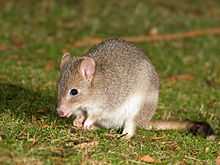Potoroidae
| Potoroidae[1] Temporal range: Late Oligocene–recent | |
|---|---|
 | |
| Woylie (Bettongia penicillata) | |
| Scientific classification | |
| Kingdom: | Animalia |
| Phylum: | Chordata |
| Class: | Mammalia |
| Infraclass: | Marsupialia |
| Order: | Diprotodontia |
| Suborder: | Macropodiformes |
| Family: | Potoroidae Gray, 1821 |
| Genera | |
|
Aepyprymnus | |
The marsupial family Potoroidae includes the bettongs, potoroos, and two of the rat-kangaroos. All are rabbit-sized, brown, jumping marsupials and resemble a large rodent or a very small wallaby.
Characteristics
The potoroids are smaller relatives of the kangaroos and wallabies, and may be ancestral to that group. In particular, the teeth show a simpler pattern than in the kangaroo family, with longer upper incisors, larger canines, and four cusps on the molars.[2] However, both groups possess a wide diastema between the incisors and the cheek teeth, and the potoroids have a similar dental formula to their larger relatives:
| Dentition |
|---|
| 3.0-1.2.4 |
| 1.0.2.4 |
In most respects, however, the potoroids are similar to small wallabies. Their hind feet are elongated, and they move by hopping, although the adaptations are not as extreme as they are in true wallabies, and, like rabbits, they often use their fore limbs to move about at slower speeds.
The potoroids are, like nearly all diprotodonts, herbivorous. However, while they take a wide variety of plant foods, most have a particular taste for the fruiting bodies of fungi, and often depend on fungi to see them through periods when little else is available to eat in the dry Australian bush. One example of a potoroo that sustains itself on fungi is the long-footed potoroo. This animal's diet is almost entirely made up of fungal spores. This limits its habitat range as it needs to live in a moist environment, with dense cover to reduce predation from introduced species such as foxes and feral cats.
Status
Four species of bettongs are extant and two are extinct. Bettongs were endangered because settlers took much of their habitat, and the foxes they introduced to the continent also killed many of them. At one time, species lived all over Australia. Today, the Tasmanian bettong lives only in the eastern half of Tasmania, and the northern bettong lives only in three isolated populations in northern Queensland.
Classification
The three extant genera of potoroids contain eight species:[1][3]
- Family Potoroidae
- Genus †Wakiewakie
- Genus †Purtia
- Genus †Ngamaroo
- Genus †Palaeopotorous
- Genus †Bulungamaya
- Genus †Gumardee
- †Gumardee pascuali
- Genus †Milliyowi
- †Milliyowi bunganditj
- Genus †Gumardee
- Subfamily Potoroinae
- Genus Aepyprymnus
- Rufous rat-kangaroo, Aepyprymnus rufescens
- Genus Bettongia
- Eastern bettong, Bettongia gaimardi
- Boodie, Bettongia lesueur
- Woylie, Bettongia penicillata
- Northern bettong, Bettongia tropica
- †Nullarbor dwarf bettong, Bettongia pusilla[4]
- †Bettongia moyesi
- Genus †Caloprymnus
- †Desert rat-kangaroo, Caloprymnus campestris
- Genus Potorous
- Long-footed potoroo, Potorous longipes
- †Broad-faced potoroo, Potorous platyops
- Long-nosed potoroo, Potorous tridactylus
- Gilbert's potoroo, Potorous gilbertii
- Genus Aepyprymnus
References
- ↑ 1.0 1.1 Groves, C. P. (2005). Wilson, D. E.; Reeder, D. M, eds. Mammal Species of the World (3rd ed.). Baltimore: Johns Hopkins University Press. pp. 56–58. OCLC 62265494. ISBN 0-801-88221-4.
- ↑ Poole, William E. (1984). Macdonald, D., ed. The Encyclopedia of Mammals. New York: Facts on File. pp. 862–871. ISBN 0-87196-871-1.
- ↑ Haaramo, M. (15 November 2005). "Mikko's Phylogeny Archive: Potoroidae - rat-kenguroos". Retrieved 2008-01-27.
- ↑ Burbidge, A. (2008). Bettongia pusilla. In: IUCN 2008. IUCN Red List of Threatened Species. Retrieved 5 January 2008.
External links
- ARKive - images and movies of the burrowing bettong (Bettongia lesueur)
- DPIWE information on the Tasmanian Bettong
- U.S. Fish & Wildlife Service Species Profile
- Australian Faunal Directory

